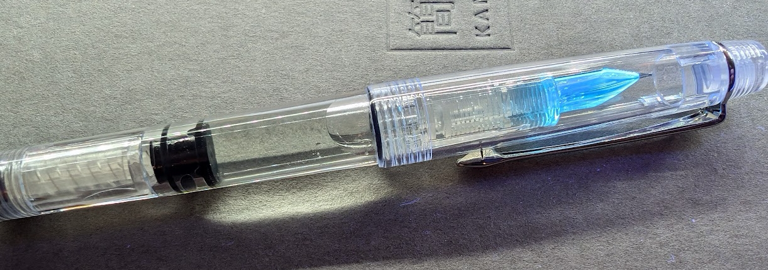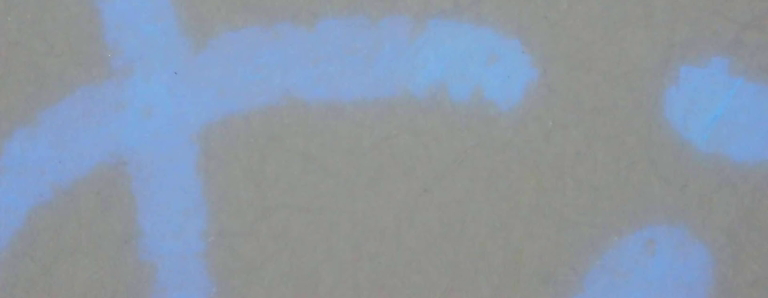UV Reactive Ink
I’ve had an interest in ultraviolet (UV) “blacklight” reactive items for many years. They come in many forms, like glow in the dark toys and decorations (LEGO ghosts!), clothing, or even certain rocks. If I can hit something with a UV light and it fluoresces or glows, I get a kick out of it. My current wedding ring even glows! Since I started using fountain pens more in the past year, I was eager to try out UV reactive fountain pen ink, but finding a suitable ink was a challenge. Not only were there not many choices, but some were not viable and others were difficult to obtain.
Safety
Before going any further, UV light has safety concerns that merit caution.
In this post, unless otherwise specified, “UV” refers to the UV-A portion of the ultraviolet spectrum around 315-400nm, specifically closer to 365nm as that is where most of the lights being discussed peak.
Though this “long wave” UV isn’t as harmful as other portions of the UV spectrum, it can still be harmful with prolonged skin exposure and any amount of eye exposure. Wear eye protection when using UV lights, and limit exposure where possible.
Many polycarbonate (PC) glasses block UV-A light. This includes safety glasses, and some others such as reading glasses or even eyeglasses, depending on how the lenses were made. Since these are very common, chances are high that many people already have some form of viable eye protection nearby. Try shining a UV light through glasses at a UV reactive object, if the object doesn’t react to the light through the glasses, but does when the glasses are not in front of the light, then the glasses can block UV light.

Any use of UV lights is at your own risk. Protect your eyes!
Turritopsis Nutricula
I found a couple UV reactive inks, but after reading several reviews and related material around the Internet, I ultimately decided that Turritopsis Nutricula by Tramol was the ink I wanted to try. I bought two 18ml bottles on AliExpress for about $5 each, which is a decent price for specialty ink. Even before getting to the ink, I liked the Jellyfish on the label. Shining a UV light on the bottle made it glow pretty brightly, which made me eager to get the ink in a pen to try it out.

Though I am aware of other alternative invisible UV fountain pen inks, I opted not to buy them for various reasons.
Initially I put the ink into a pen I purchased specifically for this purpose, a Penbbs 494 with an EF nib. I used that pen as it was relatively inexpensive and if the ink didn’t behave well, it wouldn’t be a significant loss. Eventually after using the ink for a while and seeing how well it worked, I also put the ink in a TWSBI ECO Glow Green pen with a stub nib.

Rhymes with Blinvisible
Turritopsis Nutricula is UV reactive “invisible” ink. Without UV light, the ink is not visible at all on paper. In certain cases you might see a dent in the paper from the nib of the pen, or a hint of clear wet liquid before it dries, but otherwise it looks as if nothing is on the paper. Shine a UV light on the paper and it’s a different story entirely: the ink glows a light blue color so bright it almost looks white!
The results are nothing short of amazing, writing with this ink under UV looks like you’re writing with light! I’ve been extremely impressed by it, especially for the relatively low cost. The results are improved significantly when using it in combination with certain UV lights and specific paper types, but I’ll have more on that later.

Why ask why?
As to the ink’s purpose, there are numerous fun things to do with it: hidden messages, secret additions to notes, sensitive information, drawings that glow or look different under UV and non-UV light, or just for general amusement. It also fits right in around Halloween.

Hurry up and wait
Getting the ink may present a minor challenge, however. I found it on AliExpress
under the ink name (Turritopsis Nutricula) but the listing didn’t include the
brand name. Search for terms such as uv invisible fountain pen ink and find
the bottle matching the picture earlier in this post – it should have an image
of a Jellyfish. The ink can sometimes be found on Amazon, but rarely under its
actual name, and at a much higher price. Search using the same terms I suggested
for AliExpress and you’ll probably find it. The last time I saw on Amazon, it
was about $10 for the same bottle.
When ordering from AliExpress, the ink ships from China so it takes a while to arrive. Time isn’t the only factor, however, ink in a glass bottle taking a trip that long has an increased chance of damage in transit. Even buying from Amazon, however, it may still ship from China, so carefully check the listing and confirm how it ships.

Mine arrived after two weeks in transit and the box was crumpled significantly, but the contents were safe and intact.
Other UV Ink Options
There are other UV reactive inks out there, too. There are options that are not invisible ink, and also options that aren’t fountain pens.
Highlighter Inks
While I was searching for the invisible ink I also found several UV reactive highlighter style inks from Banmi on AliExpress for about $4 per 18ml bottle. While these are not invisible, they still glow brightly under UV.

These highlighter style UV inks can be used with thinner nibs for drawing/sketching or in wider nibs as a highlighter in combination with water-resistant inks. I don’t see myself using these as often as the invisible ink but the effect is still decent overall.

I didn’t have a good way to test these as actual highlighters, but some of the more visible colors like red and pink could be good for outline/underline even if not used as typical highlighters.
Rollerball Invisible Inks
There are also non-fountain pen options out there, such as these Sakura Gelly Roll UV Gel Pens – They have a similar invisible ink effect, but in different colors. However, since these are pre-packaged disposables, you are locked into using just those pens. Also, since rollerball pens require more pressure than fountain pens, they are more likely to leave behind a visible trace on paper even if the ink itself is not visible.

Getting the Best Results
For UV reactive ink to work well, there are two major factors that come into play: The paper and the UV light source.
Picking Paper
The ideal paper for UV reactive ink is paper that does not react to UV light. When the paper does not react to UV light, it allows the ink to get the most contrast with the paper and shine brightly. If the paper reacts to UV light and glows, it can diminish or even drown out the glow of the ink.
I have a separate post about all the different paper types I have tested, but among the best ones to use that I have found thus far are Midori MD and Tomoe River S Kanso paper.

Isolating Illumination
To get the best effect with UV reactive materials, a UV light should only emit light in the UV-A range. This can be quite difficult in practice as many lights labeled as “UV” put out a much wider range and appear to give things a purple hue in addition to whichever portion of the UV spectrum they are supposed to emit.
As with the paper, I’ll have a separate post about a selection of lights I have used and tested. Generally speaking, try to find a light source with a ZWB2 filter. A ZWB2 filter blocks the visible portion of the color spectrum, so only UV-A light near 365nm can pass. This allows UV reactive materials to fluoresce and shine while minimizing discoloration by non-UV light.
Most lights I use have ZWB2 filters, including an Emisar D4v2 UV Mule, Emisar D2 with a UV channel, and Lumintop Tool AA UV.

Conclusion
Overall, these inks are fun to work with and are well worth the low cost and moderate effort to obtain. Whatever your purpose for it may be, I highly recommend trying the ink at least once. The paper and UV lights that work best with this ink also have many uses other than UV ink, so they are good to have even for general use.